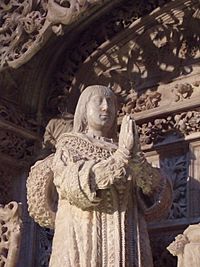Alfonso, Prince of Asturias (1453–1468) facts for kids
Quick facts for kids Alfonso |
|
|---|---|
| Prince of Asturias | |

Sculpture of Alfonso from his tomb in Burgos.
|
|
| Born | 17 November 1453 Tordesillas |
| Died | 5 July 1468 (aged 14) Cardeñosa |
| Burial | Miraflores Charterhouse |
| House | Trastámara |
| Father | John II of Castile |
| Mother | Isabella of Portugal |
| Religion | Roman Catholicism |
Alfonso the Innocent (born November 17, 1453 – died July 5, 1468) was a young prince in the Kingdom of Castile, which is now part of Spain. He became a very important figure when some powerful nobles wanted him to be king instead of his half-brother, King Henry IV. Henry had actually named Alfonso as the next in line to the throne, giving him the special title of Prince of Asturias.
Contents
Early Life of Prince Alfonso
Alfonso was the only son of King John II and his second wife, Queen Isabella of Portugal. He also had an older sister from this marriage, who would later become the famous Queen Isabella I.
After their father, King John II, passed away, Alfonso, his mother, and his sister lived a bit like they were in exile. His mother went to Arevalo, and the children moved to Segovia. When Alfonso was about seven years old, he and his sister were brought to King Henry's royal court in Madrid. They lived in the household of Queen Joan, King Henry's wife.
Who Would Be the Next King?

In the early 1460s, many important nobles in Castile were not happy with King Henry IV's rule. They also doubted if Queen Joan's daughter, Joanna, Princess of Asturias, was truly King Henry's child. Stories and rumors, spread by a group of rebellious nobles, suggested that Joanna's father was actually Beltrán de la Cueva. He was a royal favorite whom Henry had given a lot of power. Because of these rumors, Joanna became known as "Juana la Beltraneja."
If Joanna was not King Henry's legitimate daughter, then Alfonso was the next in line to the throne. If she was legitimate, then Alfonso and his sister Isabella would not have a claim to the crown. This question has been a big mystery for historians for hundreds of years.
Alfonso Becomes a Rival King
The group of nobles who supported Alfonso pushed King Henry to make a deal in 1464. This deal, called the Representation of Burgos, forced Henry to say that Joanna was not his heir. Instead, he had to recognize Alfonso as his official heir. Alfonso then became the Prince of Asturias, a title Joanna had held before. King Henry agreed to this, but he added a condition: Alfonso should marry Joanna someday. This would ensure that both of them would eventually share the crown.
However, King Henry soon changed his mind. He started to support his daughter Joanna's claim to the throne again. So, on June 5, 1465, the nobles who were against Henry held a special ceremony outside the city of Avila. They pretended to remove Henry from power and crowned Alfonso as their new king. This event is known as the Farce of Ávila. After this, Alfonso began giving out land and titles as if he were already the true ruler. This started a civil war in Castile. A major battle happened in 1467, called the Second Battle of Olmedo, but it ended without a clear winner.
Alfonso's Death
Sadly, in 1468, Alfonso suddenly passed away when he was only 14 years old. The exact reason for his death is not known. It was likely due to an illness like consumption or plague. However, some people rumored that he might have been poisoned by his enemies.
Alfonso was buried near his father, King John II, at the Miraflores Charterhouse. Later, his mother, Isabella of Portugal, was also buried there. His sister, Isabella, ordered beautiful tombs for them. In 2006, during some restoration work at the charterhouse, scientists studied the tombs. They found Alfonso's remains in a wooden coffin. His height was estimated to be about 165 centimeters (around 5 feet 5 inches).
In 2013, a new study suggested that Alfonso might have been poisoned. His symptoms did not match those of the Bubonic plague, and no trace of the plague bacteria was found in his remains.
Before he died, Alfonso's will said that his crown should go to his sister, Isabella. She was asked to take his place as the leader of the rebels. At first, she said no. But after some talks at Toros de Guisando, King Henry was convinced to remove Joanna la Beltraneja from the line of succession. He recognized Isabella as his official heir. Even though Henry tried to go against this decision later, his efforts didn't work. He remained at peace with Isabella for the rest of his rule. Isabella became the next queen of Castile when Henry died in 1474.
See also
 In Spanish: Alfonso de Castilla para niños
In Spanish: Alfonso de Castilla para niños

